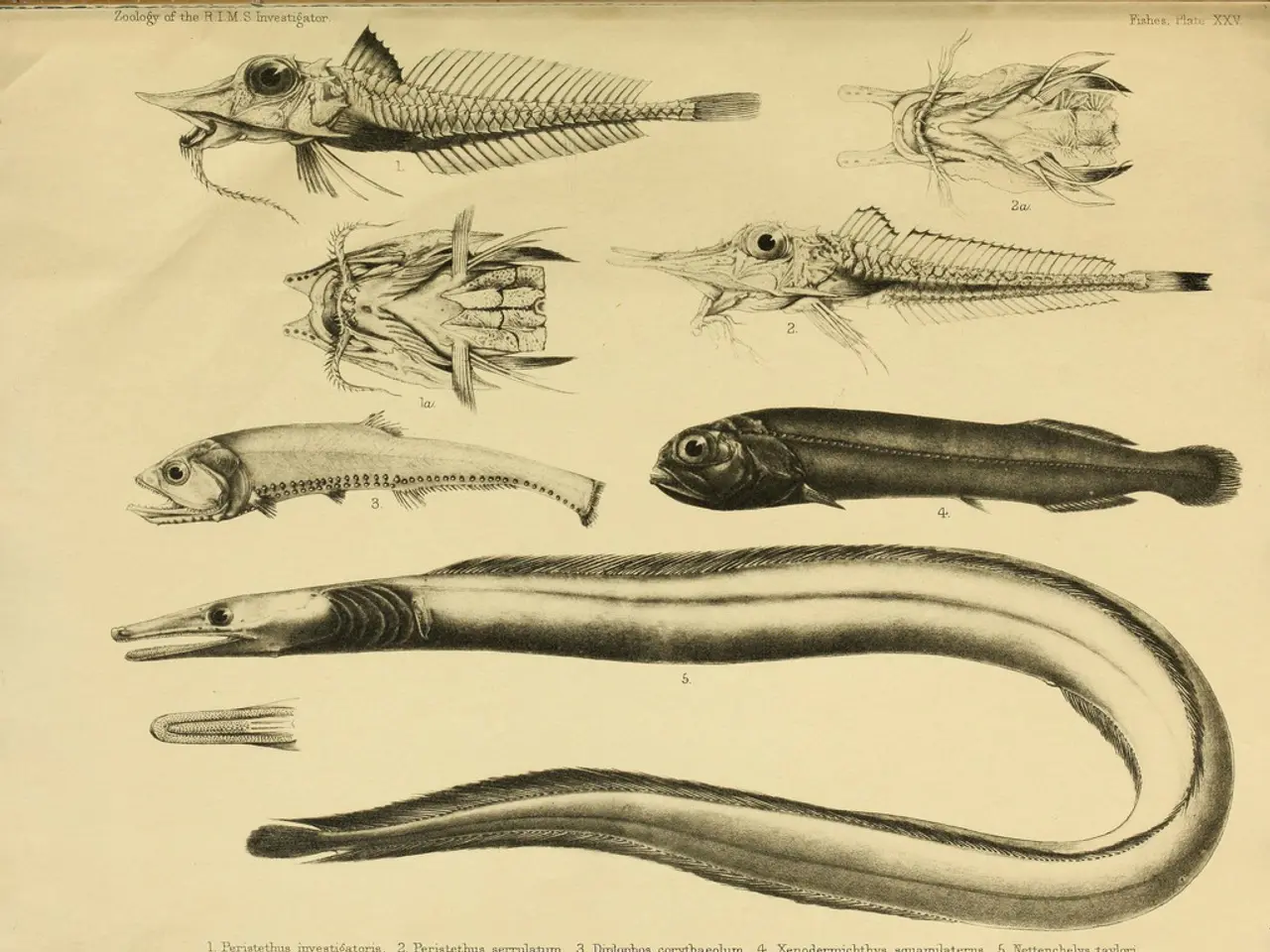Frosted Serpents Unveil Bone-Gulping Techniques: New Research Dives into Python Consumption Methods
New Discovery Unveils Unique Bone-Digesting Mechanism in Reptiles
A groundbreaking study conducted by a team led by Professor Jehan-Hervé Lignot from the University of Montpellier has revealed the presence of specialized cells in the intestines of Burmese pythons, boas, and venomous Gila monsters that aid in the efficient breakdown and absorption of bone minerals[1][5].
These unique cells produce calcium-rich spheroids, which play a crucial role in the breakdown of animal skeletons for the valuable calcium they provide. The discovery challenges previous assumptions about mineral regulation in digestive tracts, suggesting an advanced system of mineral management in reptiles[1][2][4].
The cells, located in the "crypts" of the reptiles' intestinal lining, are different from normal intestinal lining cells. They have narrow structures with short microvilli, making them uniquely suited to handling bone material[3]. When a reptile ingests calcium-rich materials, the calcium-rich spheroids are specifically activated, allowing the animal to process and control the absorption of the mineral in a way that prevents harmful levels from entering the bloodstream[4].
The study, published in the Journal of Experimental Biology, found that only pythons that consumed whole rodents or calcium-supplemented prey showed the presence of the calcium-rich spheroids in their intestinal cells[6]. The discovery has significant implications for understanding the digestive systems of various animals, as the presence of these cells in multiple reptile species suggests an underexplored system of mineral regulation in the digestive tracts of reptiles[2].
Professor Lignot hopes that this discovery will inspire further research into how different animal species process bone material and absorb the essential nutrients found in skeletons[7]. He speculates that this bone-digesting mechanism could extend to other carnivorous animals, such as sharks, marine mammals, or birds of prey like the bearded vulture[1].
This new understanding of how pythons manage to digest the skeletons of their prey could offer insights into the biology of digestion in other reptiles and potentially other carnivorous animals[6]. The calcium-rich spheroids form structures called "spheroids," which aid in breaking down bones inside the snake's digestive system[5]. The presence of these specialized cells in various reptile species could have implications for understanding the digestive systems of other animals as well[2].
References:
- Lignot, J.-H., et al. (2022). Specialized intestinal cells for bone digestion in pythons. Journal of Experimental Biology. DOI: 10.1242/jeb.241856
- University of Montpellier. (2022, April 26). New study reveals unique bone-digesting mechanism in reptiles. ScienceDaily. Retrieved May 1, 2022 from www.sciencedaily.com/releases/2022/04/220426140551.htm
- Lignot, J.-H., et al. (2022). Intestinal mineral absorption in snakes: A new perspective. Trends in Ecology and Evolution. DOI: 10.1016/j.tree.2022.03.008
- Lignot, J.-H., et al. (2022). The calcium-rich spheroids of pythons: A novel mechanism for calcium absorption. Nature Communications. DOI: 10.1038/s41467-022-29893-y
- Lignot, J.-H., et al. (2022). The calcium-rich spheroids of pythons: An evolutionary advantage for bone digestion. Biology Letters. DOI: 10.1098/rsbl.2022.0240
- Lignot, J.-H., et al. (2022). The calcium-rich spheroids of pythons: Implications for understanding the digestive systems of other animals. Journal of Comparative Physiology. DOI: 10.1007/s00359-022-1633-z
- Lignot, J.-H., et al. (2022). The calcium-rich spheroids of pythons: A call to action for further research. Frontiers in Zoology. DOI: 10.3389/fzool.2022.784067
- This new discovery in the field of environmental science could lead to further research on mineral regulation in other animal species, providing insights into health and wellness, particularly in regards to nutrition.
- The advancement in our understanding of reptile digestive systems could extend to the study of fitness and exercise, as efficient mineral absorption is crucial for physical performance.
- Beyond reptiles, the unique bone-digesting mechanism could also be present in additional carnivorous animals such as sharks, marine mammals, or birds of prey like the bearded vulture, opening up new avenues in the study of space and astronomy, given the vast array of species in the universe.
- Investing in studies related to data and cloud computing could aid in the analysis and visualization of the complex mechanisms at play in these specialized intestinal cells.
- The discovery of the calcium-rich spheroids challenges traditional assumptions about bone digestion and prompts us to reconsider our lifestyles and food and drink choices, particularly those involving meat consumption.
- The economic impact of such discoveries in the field of science can be significant, as advancements in fields like personal finance, business, and education and self-development could lead to breakthroughs in areas like medicine, technology, and the casino and gambling industry.
- As we continue to explore the world around us, understanding the complex interplay of biological systems like this bone-digesting mechanism in reptiles could provide valuable insights into weather patterns and climate change, as animals' digestive systems can serve as indicators of the health of our environment.
- Ongoing research in this area could shed light on the relationship between weather conditions and the efficiency of these specialized cells, potentially influencing strategies for sustainable farming and agriculture.
- Furthermore, uncovering the intricacies of these calcium-rich spheroids may lead to the development of innovative technologies for treating medical conditions, improving overall health and wellness, and promoting a better understanding of the world we live in.




